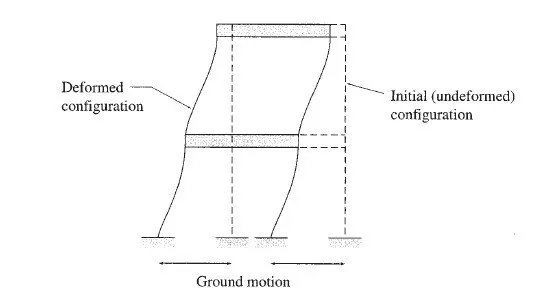An earthquake is a sudden undulation of a portion of the earths surface. Although the ground surface moves in both horizontal and vertical directions during an earthquake, the magnitude of the vertical component of ground motion is usually small and does not have a significant e¤ect on most structures. It is the horizontal component of ground motion that causes structural damage and that must be considered in designs of structures located in earthquake-prone areas.
During an earthquake, as the foundation of the structure moves with the ground, the above-ground portion of the structure, because of the inertia of its mass, resists the motion, thereby causing the structure to vibrate in the horizontal direction (Fig. 2.8). These vibrations produce horizontal shear forces in the structure. For an accurate prediction of the stresses that may develop in a structure in the case of an earthquake, a dynamic analysis, considering the mass and sti¤ness characteristics of the structure, must be performed. However, for low- to medium-height rectangular buildings, most codes employ equivalent
static forces to design for earthquake resistance. In this empirical approach, the dynamic e¤ect of the earthquake is approximated by a set of lateral (horizontal) forces applied to the structure, and static analysis is performed to evaluate stresses in the structure. The ASCE 7 Standard permits the use of this equivalent lateralforce procedure for earthquake design of buildings. According to the ASCE 7 Standard, the total lateral seismic force that a building is designed to resist is given by the equation
in which SDS is the design spectral response acceleration in the short period range; R denotes the response modification factor; and I represents the importance factor. The ASCE 7 Standard further specifies upper and lower limits for the values of CS to be used in design. The design spectral response acceleration (SDS), used in the evaluation of the design base shear, depends on the geographical location of the structure, and can be obtained using the contour maps provided in the ASCE 7 Standard. The response modification factor R takes into consideration the energy-dissipation capacity of the structure; its values range from 1.25 to 8. For example, for plain unreinforced masonry shear walls, R = 1:5; whereas, for moment resisting frames, R ¼ 8. The values of I to be used for estimating earthquake loads are given in Table 2.3. The total lateral force V thus obtained is then distributed to the various floor levels of the building using the formulas provided in the ASCE 7 Standard. For additional details about this equivalent lateral- FIG. 2.8 E¤ect of Earthquake on a Structure 36 CHAPTER 2 Loads on force procedure, and for limitations on the use of this procedure, the reader is referred to the ASCE 7 Standard.




